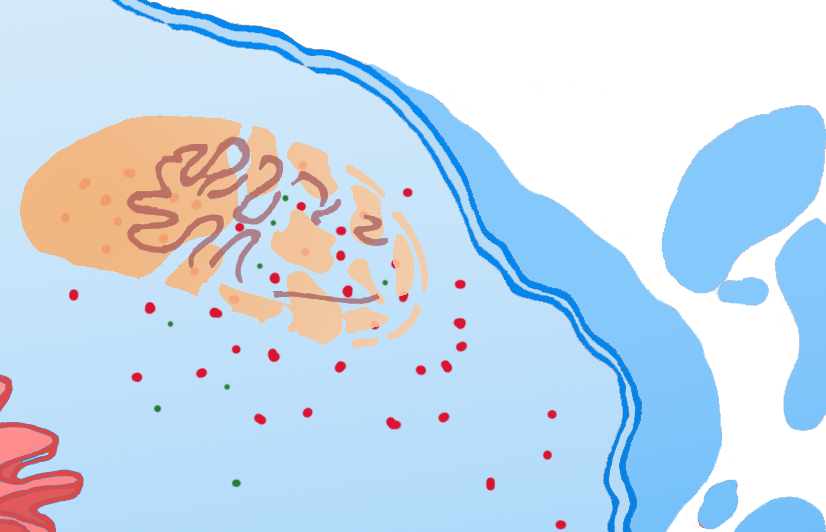Team:Warsaw/Project/apoptosis
From 2009.igem.org
(New page: {{WarHead1|project=block|team=none|modelling=none|lab=none}} ==Induction of [https://2009.igem.org/Team:Warsaw/Glossary#apoptosis apoptosis]== ==Theoretical basis== [[Image:Mito apo.png|...) |
(→Theoretical basis) |
||
| Line 6: | Line 6: | ||
==Theoretical basis== | ==Theoretical basis== | ||
[[Image:Mito apo.png|thumb|right|280px]] | [[Image:Mito apo.png|thumb|right|280px]] | ||
| - | Mitochondrial outer membrane permabilization MOMP is one of the main programmed cell death mechanisms. The process is regulated by PTPc complex and Bcl2 family proteins [17]. Many | + | Mitochondrial outer membrane permabilization MOMP is one of the main programmed cell death mechanisms. The process is regulated by a PTPc complex and a Bcl2 family proteins [17]. Many types of cancer involve disruption of this process therefore inducing MOMP in the tumour cells is regarded as a potential therapeutic solution. MOMP-inducing factors include the [https://2009.igem.org/Team:Warsaw/Glossary#p53 p53] protein, which is mutated in almost half of the cancer cases. By acting as a transcription regulator in the nucleus, [https://2009.igem.org/Team:Warsaw/Glossary#p53 p53] arrests the cell cycle and induces [https://2009.igem.org/Team:Warsaw/Glossary#apoptosis apoptosis] [18]. In the cytoplasm [https://2009.igem.org/Team:Warsaw/Glossary#p53 p53] interacts with mitochondrial membrane and can enter the mitochondrion. It has been proven that these processes induce [https://2009.igem.org/Team:Warsaw/Glossary#apoptosis apoptosis] and does not influence the cell cycle. In the mitochondrion [https://2009.igem.org/Team:Warsaw/Glossary#p53 p53] is an effector protein that activates soluble (cytochrom c, Smac) and insoluble (AIF, EndoG) apoptototic factors. Moreover interaction of [https://2009.igem.org/Team:Warsaw/Glossary#p53 p53] and Bax protein in vitro leads to permabilisation of a lipid bilayer analogous to mitochondrial membrane. [12] Because [https://2009.igem.org/Team:Warsaw/Glossary#p53 p53] is inactive in tumour cells many research groups focused on designing gene therapies based on [https://2009.igem.org/Team:Warsaw/Glossary#p53 p53] gene delivery. Most frequently adenoviruses and eukaryotic plasmids are used. The results confir increased effectiveness of chemotherapeutic drugs following introduction of [https://2009.igem.org/Team:Warsaw/Glossary#p53 p53] gene copy into the cell [4]. It has been shown that [https://2009.igem.org/Team:Warsaw/Glossary#p53 p53] with the mitochondrial leader sequence alone is sufficient to induce [https://2009.igem.org/Team:Warsaw/Glossary#apoptosis apoptosis] in mammalian cells. Fusion protein Lp53, with mitochondrial leader sequence from ornithine transcarbamylase was used. In terms of [https://2009.igem.org/Team:Warsaw/Glossary#apoptosis apoptosis] induction fusion protein was almost as effective as standard [https://2009.igem.org/Team:Warsaw/Glossary#p53 p53]. Previous research did not include the delivery of [https://2009.igem.org/Team:Warsaw/Glossary#p53 p53] into tumour cells by bacterial vectors. Our project proposes a method to induce apoptosis without arresting the cell cycle. Cell cycle arrest decreases the sensitivity of cancer cells to chemotherapeutic agents, because they can affect only proliferating cells [14]. |
==Details== | ==Details== | ||
Revision as of 21:00, 21 October 2009
Contents |
Induction of apoptosis
Theoretical basis
Mitochondrial outer membrane permabilization MOMP is one of the main programmed cell death mechanisms. The process is regulated by a PTPc complex and a Bcl2 family proteins [17]. Many types of cancer involve disruption of this process therefore inducing MOMP in the tumour cells is regarded as a potential therapeutic solution. MOMP-inducing factors include the p53 protein, which is mutated in almost half of the cancer cases. By acting as a transcription regulator in the nucleus, p53 arrests the cell cycle and induces apoptosis [18]. In the cytoplasm p53 interacts with mitochondrial membrane and can enter the mitochondrion. It has been proven that these processes induce apoptosis and does not influence the cell cycle. In the mitochondrion p53 is an effector protein that activates soluble (cytochrom c, Smac) and insoluble (AIF, EndoG) apoptototic factors. Moreover interaction of p53 and Bax protein in vitro leads to permabilisation of a lipid bilayer analogous to mitochondrial membrane. [12] Because p53 is inactive in tumour cells many research groups focused on designing gene therapies based on p53 gene delivery. Most frequently adenoviruses and eukaryotic plasmids are used. The results confir increased effectiveness of chemotherapeutic drugs following introduction of p53 gene copy into the cell [4]. It has been shown that p53 with the mitochondrial leader sequence alone is sufficient to induce apoptosis in mammalian cells. Fusion protein Lp53, with mitochondrial leader sequence from ornithine transcarbamylase was used. In terms of apoptosis induction fusion protein was almost as effective as standard p53. Previous research did not include the delivery of p53 into tumour cells by bacterial vectors. Our project proposes a method to induce apoptosis without arresting the cell cycle. Cell cycle arrest decreases the sensitivity of cancer cells to chemotherapeutic agents, because they can affect only proliferating cells [14].
Details
Directing bacterial proteins to mammalian mitochondria.
One of the nescessary objectives is to direct a fraction of secreted proteins into the mitochondrion. This will be achieved by fusion of mitochondrial leader sequence from human protein Cox1 to the N-terminus of proteins. It has been shown that 40 amino acids long N-terminal sequence is enough for effective transport of Cox1 across the mitochondrial membrane. First the efficiency of the process will be assessed by detection of Red Fluorescent Protein with confocal microscopy. The red fluorescence should be visible in the mitochondria of the cells invaded by bacteria expressing RFP fused with the mitochondrial leader sequence. Then the ability to induce apoptosis by mitochondrially directed p53 will be investigated. Apoptosis induction will be confirmed by flow cytometry [8]. In addition we will use confocal microscopy to monitor the process. In both cases cells will be stained with propidium iodide and annexin V.
 "
"
